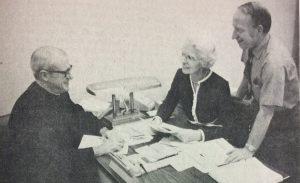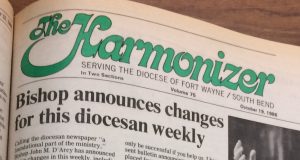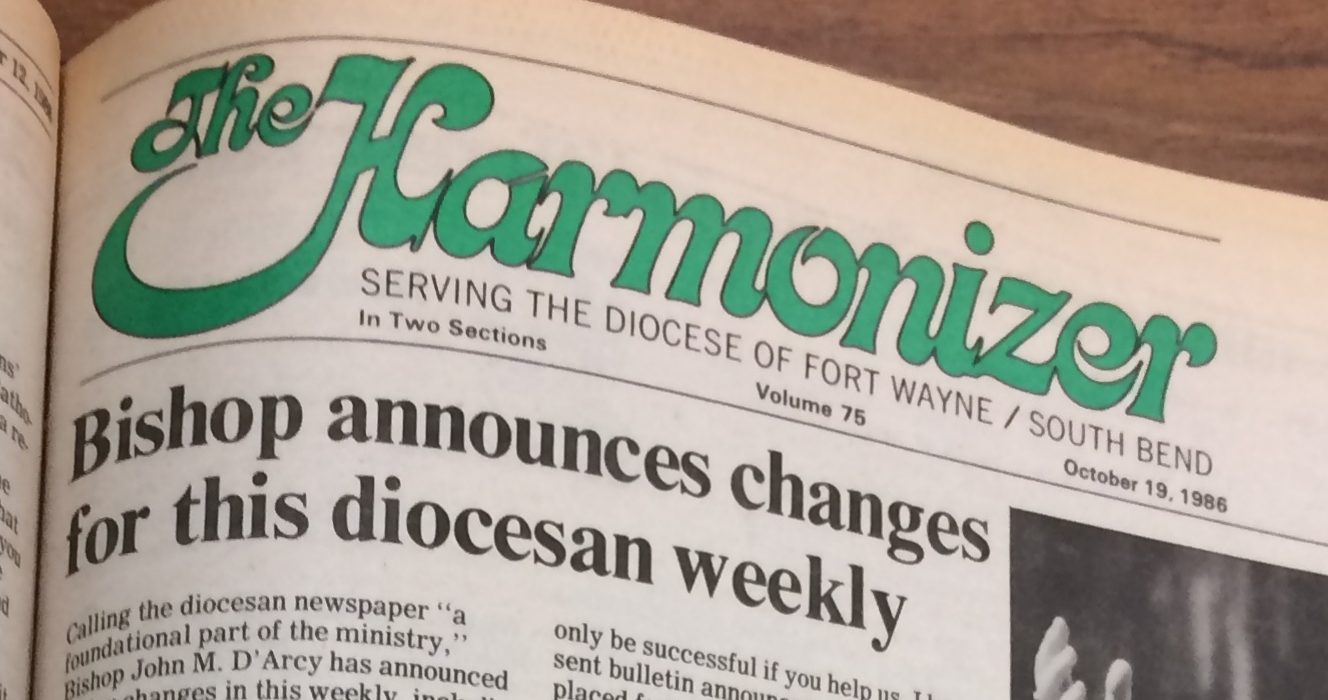August 25, 2017 // Diocese
Change, challenge and commitment: Today’s Catholic
By its very nature, a great challenge faced by the publishers of print media is to remain viable, meaningful and interesting, yet entertaining, to its readers. In fact, there may be as many reasons for subscribing to a publication as there are subscribers.
Certainly, subscriber trends must be recognized for the survival of a given medium. Couple this with the responsibility and concerns of Catholic publications in today’s secular culture: It’s one fraught with the dictatorship of relativity, which would prefer pushing aside the truth and beauty of Christ’s teachings in favor of the current “if-it-feels-good-do-it” notion encouraged by Hollywood, the internet, secular media and political correctness. Facing such concerns is vital to meeting and being in the mix for an organization that holds forth informing the truth of its tenants.

Msgr. James P. Conroy, Dorothy Brodrick and managing editor Bill Roberts are shown judging the names for the new diocesan paper in 1972. The Harmonizer was chosen.
 In 1912, Father John Noll stood up to face a dangerous form of socialism that opposed religion, morality and private ownership — then pervading the nation — when he founded Our Sunday Visitor to inform the Catholic laity and their friends. As early as the years 1902–03, Father John Noll had been writing and distributing Kind Words From Your Pastor, which, as he recalled, began a literary career of keeping his parishioners up to date and informed. It was a small paper that lasted for 24 editions. A few years later, in 1908, he published Parish Monthly. It contained reading described as being of general interest and serving some 200 parishes across the nation.
In 1912, Father John Noll stood up to face a dangerous form of socialism that opposed religion, morality and private ownership — then pervading the nation — when he founded Our Sunday Visitor to inform the Catholic laity and their friends. As early as the years 1902–03, Father John Noll had been writing and distributing Kind Words From Your Pastor, which, as he recalled, began a literary career of keeping his parishioners up to date and informed. It was a small paper that lasted for 24 editions. A few years later, in 1908, he published Parish Monthly. It contained reading described as being of general interest and serving some 200 parishes across the nation.
In 1910 Father Noll was transferred to St. Mary Parish in Huntington and acquired a printing press from a local newspaper. It was then that he made a first run of 35,000 copies of Our Sunday Visitor for a May 5, 1912, distribution at parish churches. Father Noll’s editorial in those weekly copies stated that “this Sunday Visitor will insist on going home with you from Mass, and will instruct and entertain you all for the price of one penny a paper.” He recognized the critical need to reach out, focusing in those early issues on a response to the anti-Catholic and socialistic propaganda that spewed from a contemporary publication, The Menace.
The Menace had been founded in 1911 with a mission to attack the church. It bitterly assailed the Catholic Church, accusing its members of planning attacks on American freedom and liberty. The Menace did not prevail, however, and disappeared some 85 years ago. Our Sunday Visitor attained the largest circulation of any Catholic paper in the world. From this publishing enterprise also came pamphlets, monthly collection envelopes, brochures and books, as well as The Acolyte, a periodical for priests.
Then-Msgr. Noll was notified on May 13, 1925, that Pope Pius XI had named him the successor of Bishop Herman Joseph Alerding, who died in December 1924. Following his new appointment, Bishop Noll founded the diocesan weekly paper Our Sunday Visitor Fort Wayne Edition, which became the forerunner of The Harmonizer.
At first the newspaper contained the national edition of Our Sunday Visitor, with 10 or so pages dedicated to diocesan and general Catholic news directed at most Catholic homes in the dioceses. A commitment to fulfill a need was being served. By January 1926, this newly directed publication was being printed as a diocesan paper and featured items of interest intended to encourage and inform the laity.
Bishop Noll recognized that additional readers could be reached, and circulation expanded, by addressing one particular segment of the population. So Our Sunday Visitor introduced a youth section in 1939 and expanded the publication by eight pages. Now stories of interest especially directed toward younger audiences could be developed to teach and direct young minds in ways the Lord could be served. Young members of the laity now had access to activities, organizations and events through which they might grow morally stronger.
By 1967 the Fort Wayne-South Bend diocesan edition had changed editors. Under Bishop Noll, Francis Fink has served as a temporary managing editor at one point, and as editor following Archbishop Noll’s death. Msgr. Joseph Crowley then served as editor from 1958-67. In 1967, Msgr. Joseph Crowley left to become a pastor, and Msgr. James P. Conroy, who had been editing the youth column, took over.
After Vatican II, circulation of the newspaper experienced somewhat of a decrease. Msgr. Conroy, however, increased local news and pursued the notion the publication should be renamed. A contest among readers was held, and Msgr. Thomas Durkin suggested the name The Harmonizer, which was adopted. As historian and author of “Worthy of the Gospel of Christ,” Joseph White, wrote, “For an era when there were deep divisions about Vatican II reforms, the title projected a positive tone. With the Dec. 3, 1972, issue, the diocesan newspaper took its new name. The Harmonizer had a circulation 25,376 in 1976.”
In 1986, the Diocese of Fort Wayne-South Bend took ownership of The Harmonizer at the request of Our Sunday Visitor Inc. On Oct. 26, 1986, the name was changed to Today’s Catholic.
Once again, Joseph White offers the following information: “… in 1985, Father Vincent Giese was acting editor of The Harmonizer, pending a return to full-time work at Our Sunday Visitor. In August 1986, John Ankenbruck, a veteran reporter, columnist and editorial writer for the Fort Wayne newspaper The News-Sentinel became editor. He was succeeded in 1998 by William Cone, an experienced newspaper editor in Florida. When Cone left the position in 2003 to become editor of the Pittsburgh Catholic, Timothy Johnson, a resident of Yoder, Indiana, and assistant editor since 1998, became editor.” Presently, Jodi Marlin serves as editor of Today’s Catholic.
Today we come to another watershed moment in Bishop Noll’s remarkable publication legacy. Named an archbishop in 1953 for his contributions to the Catholic press and the work of the church in America, what might Archbishop Noll have imagined possible of the immediate response, the color and the worldwide accessibility that print, knitted carefully and wonderfully with what digital technology, offers? A new technology is necessary to stay in contact with the new generations of Catholics, without removing the familiar and comfortable newspaper genre, to which so many Catholics have accustomed themselves. It’s where Today’s Catholic must have a presence, in order to remain the viable vehicle for spreading the truth and beauty of Christ’s church on earth.
From being a newspaper, Today’s Catholic has evolved into a multiplatform media outlet that will meet the commitment of the challenges that change brings about.
The best news. Delivered to your inbox.
Subscribe to our mailing list today.






